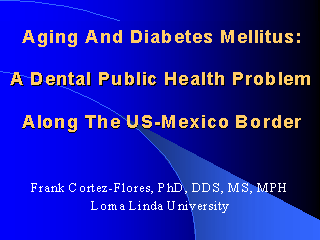|
|
|
|
front
|1
|2
|3
|4
|5
|6
|7
|8
|9
|10
|11
|12
|13
|14
|15
|16
|17
|18
|19
|20
|21
|22
|23
|24
|25
|26
|27
|28
|29
|30
|31
|32
|33
|34
|review
|

More in-depth information on Diabetes Mellitus can be found at the following URLs (internet links): Diabetes URL: http://www.va.gov/health/diabetes/ http://www.paho.org/English/HCP/HCN/DiabetesMellitus.htm http://www.idf.org/eng/idfpr_art_central_america.htm http://www.who.int/ncd/dia/index.htm
Spanish text URL: |
My primary dental public health interest is highlighting the importance of oral
infections in patients with diabetes mellitus. The goal of the diabetes lecture
(Oral Health Lectures Series) is to promote the early recognition of Type 2
Diabetes Mellitus (Type 2 DM) and improve the understanding of diabetic risk
factors involved in the prevention, surveillance and control of oral infections.
Type 2 diabetes, a non-communicable disease, is a major public health problem
affecting certain ethnic groups. The theme of the lecture/presentations is
awareness and learning.
Although space constraints does not allow addressing every infection that is seen in patients with diabetes, this lecture will stress the assertion that oral infections (e.g., periodontal diseases) may cause substantial morbidity in such patients. It is extremely important to know what is the impact of diabetes on oral health and which are the risk factors that contribute to the development/morbidity of Type 2 DM. This information allows the health professionals to measure the burden of the disease and develop and implement ways of controlling and/or minimize the risk factors. Thus, dental public health practitioners as well as primary health care providers should be aware of the impact of diabetes on oral health. The prevalence of Type 2 DM, which increases with age, is particularly high among women over age 40. The American Diabetes Association (ADA) has identified a number of screening factors to recognize individuals with high risk of developing Type 2 diabetes. Some of these risk factors as identified by the ADA are family history of Type 2 diabetes, Body Mass Index (BMI) greater than 30, ethnicity, age (40 years old and older), and, in women, a history of gestational diabetes and/or having a baby weighing nine or more pounds at birth. Furthermore, a survey of the literature has revealed that a number of diabetes studies have been conducted in the American southwestern states, particularly in Texas, New Mexico, and Colorado, that demonstrated a high prevalence of diabetes in the Hispanic population. Of interest to this presentation, and as maintained by the Bureau of the Census (1990), the majority of Hispanic Americans live in the south-central and southwestern United States. LEARNING OBJECTIVES
|